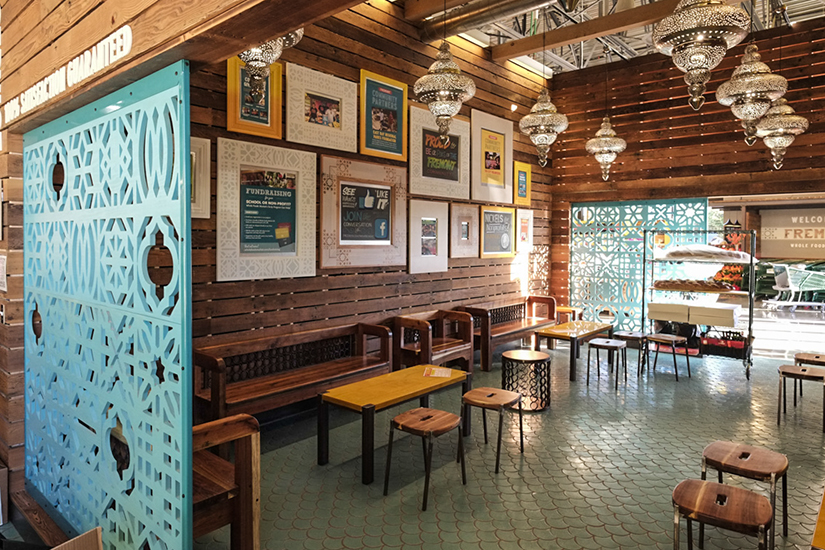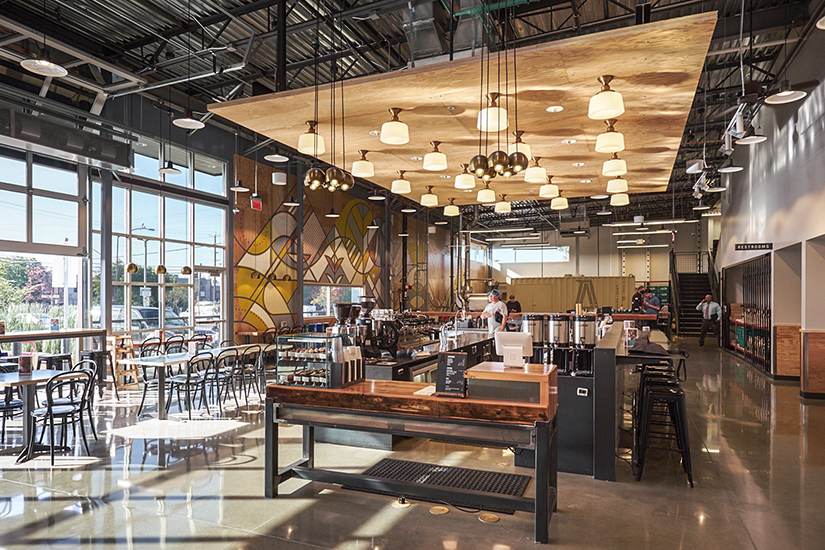|
Getting your Trinity Audio player ready...
|
It’s 2008, and R. Adam Smith is in the practice of opening between four and six new Whole Foods Markets each year. He’s just started work on the design of a new store in Santa Rosa, California. Enter the infamous economic crash, causing building projects around the world to pause or shut down.
“I was looking at this giant, 50,000-square-foot box,” Smith now recalls a decade later, as executive director of store development for Northern California and Reno. The Santa Rosa store’s large footprint meant more perishable inventory, which immediately became a concern to the company. “We tried a bunch of different concepts to minimize our exposure, to shrink—and we still had this big space left over.”
Construction began, and Smith still had space he needed to fill. For inspiration, he looked to the history and local culture of the area. “Santa Rosa, in Sonoma County, is kind of at the epicenter of craft beer,” Smith explains, “so we came up with the idea of this taproom.” This happened to be the first of its kind in any Whole Foods Market. “We were designing this separate venue on a dual-track timeline, and it was very down-to-the-wire whether we were going to get it done in time for the opening.”

The store—and taproom—did debut on time, to huge success. These exemplified Smith’s philosophy of grocery stores as places for people to gather and connect around food. “We originally created this space that we thought would have relevance to people who enjoy craft beer and pay homage to the producers in the area,” he says. “When you’re going into a community to create a gathering space, it makes sense to do as much as you can to understand that community.”
Smith’s relationship to food was forged at ten years old, when his dad, a US air force fighter pilot, was stationed in Germany and settled the family in a small village near the Luxembourg border. On school days, Smith waited for the bus and ate warm bread handed to him by the baker making his morning delivery, while local women went to the market with their baskets for their midday meals. Spending those formative years in a culture that revolved around families gathering together over fresh, locally sourced food had a lasting impression. “It’s what led me to want to pursue a career as a restaurant chef and in the food industry,” he says.

Smith went to culinary school and worked as a chef in restaurants across the country, including New York, Virginia, Colorado, and California, where he enjoyed sharing the farm-to-table culture that he grew up with, but he also felt he could do more to promote healthy eating. The diners he served already had a passion for food. “I wasn’t really converting anyone,” Smith recalls. “While it felt really good to make the connection, and people enjoyed it, I just felt something was missing.”
Two years later, Smith got a call from Whole Foods Market, which was looking for chefs to elevate its prepared foods program. It was there he quickly found what he had been missing in his previous roles: a sense of diversity in what he could offer and whom he could serve. “I was exposed to people who were coming to Whole Foods Market for any number of different reasons,” Smith says, from foodies who wanted the best in-season ingredients to cancer patients looking to support their treatment with a healthier diet and lifestyle. “I felt like there were so many areas of intersection available to get this message out about how important good food and sustainability are to support healthy communities.”

Smith establishes this early in the store-design process, meeting with community groups related to health, food access, jobs, and culture to understand what the community needs and to introduce them to Whole Foods. “It’s a great way to start a dialogue that will lead to making decisions about emphasizing a certain product mix in the store as well as certain design concepts,” he says. In-store restaurants are a prime example, which create excitement in the store and reinforce the concept of connection around food. “We may partner with a local vendor who’s prominent in the neighborhood to provide both a bridge to the community and access to a vendor who may want to grow.”
Smith also tries to push the design of each store as late as possible in the timeline, which averages 24 months from lease signing to opening. “We understand very clearly that the retail environment changes much more quickly than design and construction,” he says. “What is the cronut two years from now? If we develop programs around what’s hot in the market right now, we may be missing the mark by the time we open.” Smith’s team tries to be as predictive as they can about where the industry is going, but also aims to create spaces that are flexible and can accommodate changes.
The high-touch approach Smith takes to get each store right requires more time and effort than it would to “drop a box from the sky,” as he is known to say, but he finds that the payoff—stores that are unique and feel like part of the contextual fabric of their communities—is worth it. “I could work on a project for ten years before it opens,” he says. “Once the store is built, and we open that store and see how our team members and our customers interact in that space—that’s really the best part of my job.”


